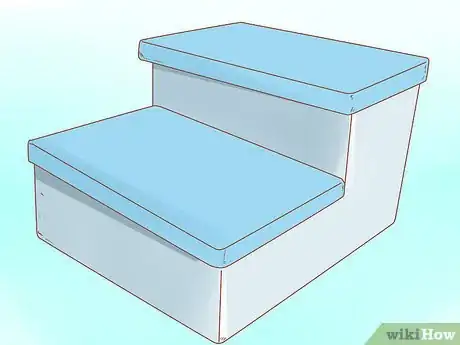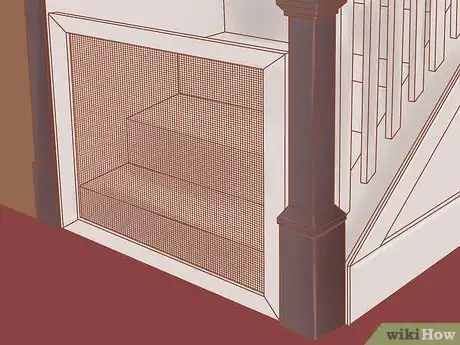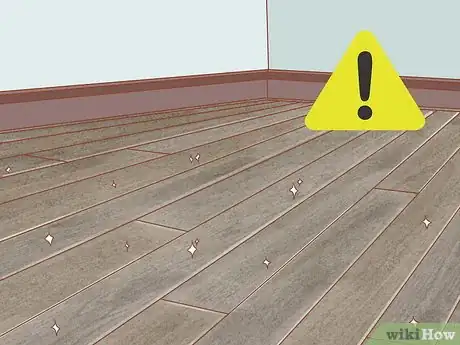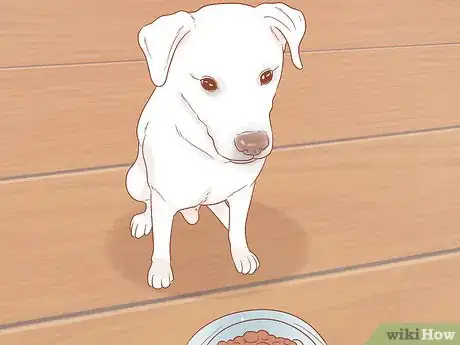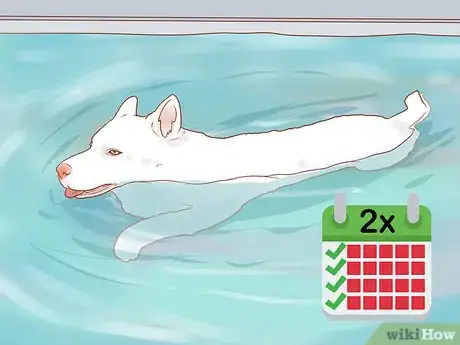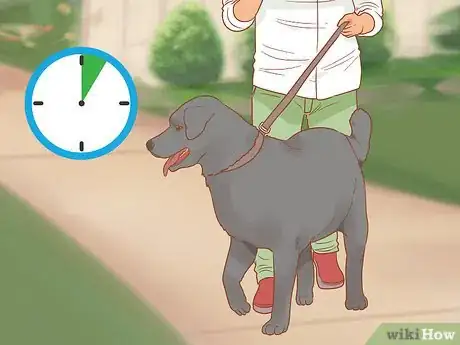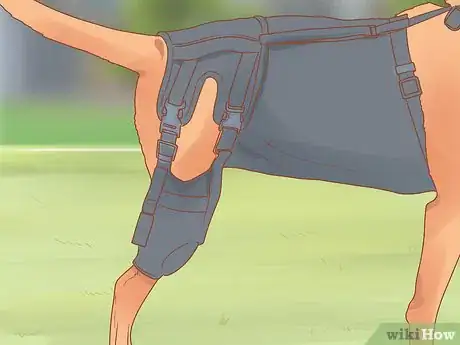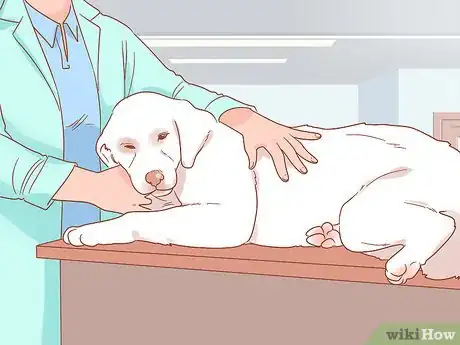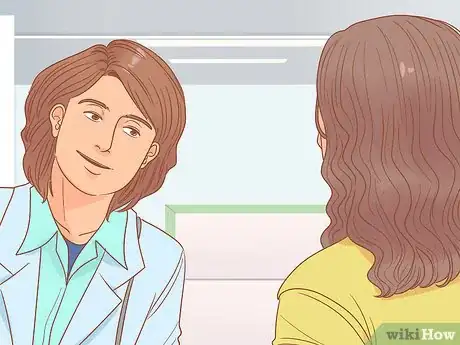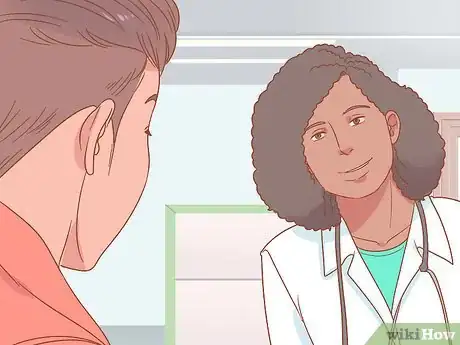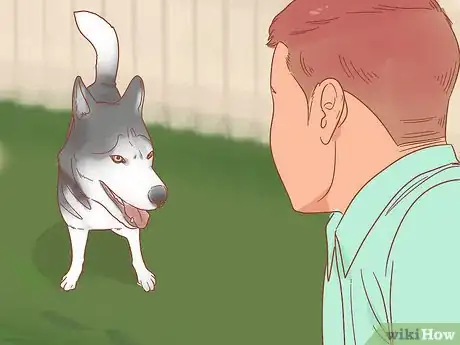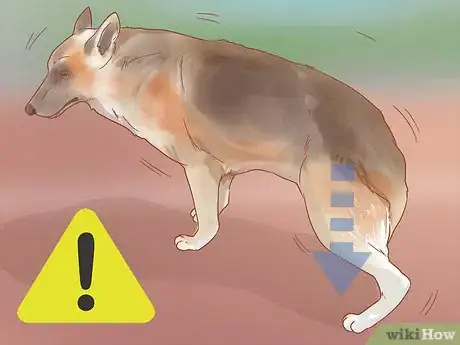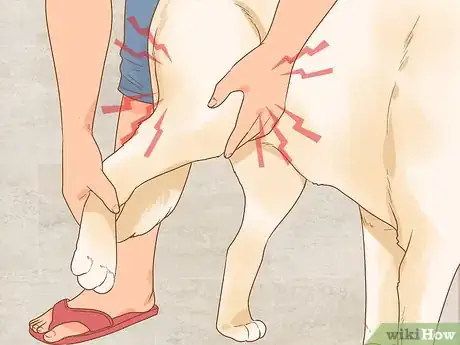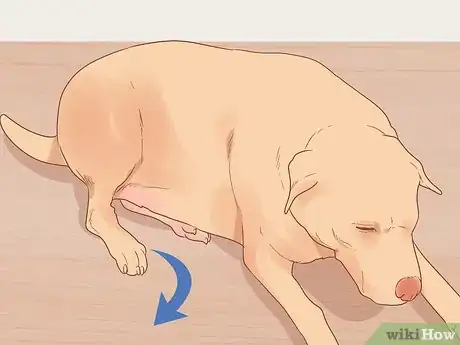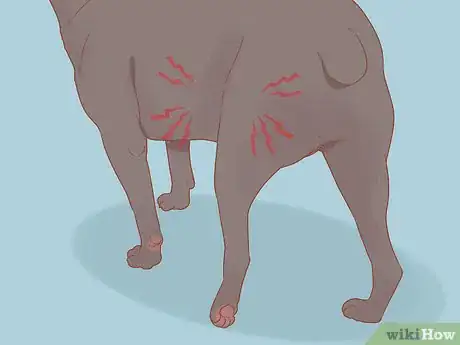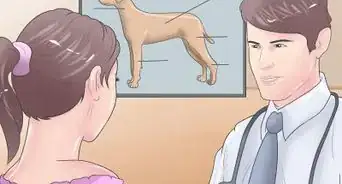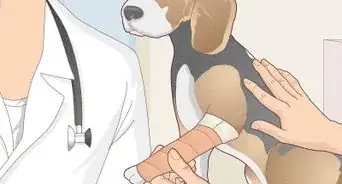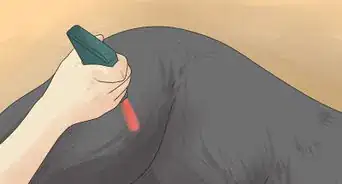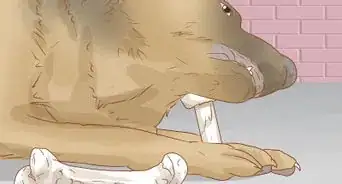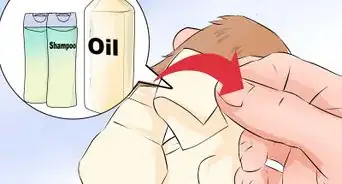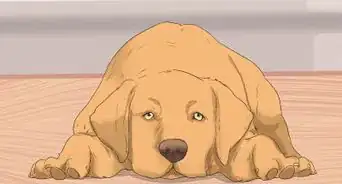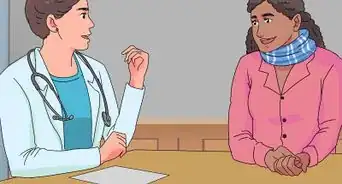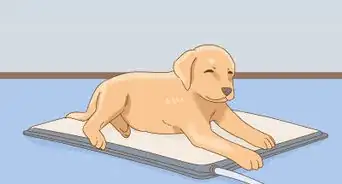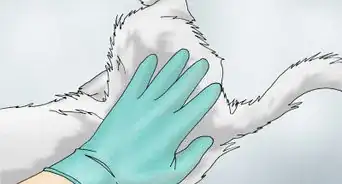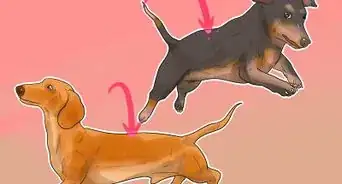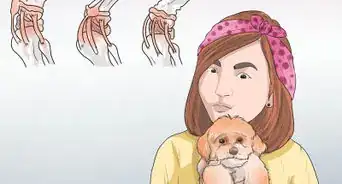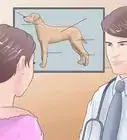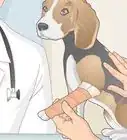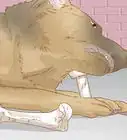This article was co-authored by Ray Spragley, DVM and by wikiHow staff writer, Danielle Blinka, MA, MPA. Dr. Ray Spragley is a Doctor of Veterinary Medicine and the Owner/Founder of Zen Dog Veterinary Care PLLC in New York. With experience in multiple institutions and private practices, Dr. Spragley’s specializations and interests include non-surgical management of cranial cruciate ligament tears, Intervertebral Disk Disease(IVDD), and pain management in osteoarthritis. Dr. Spragley holds a BS in Biology from SUNY Albany and has a Doctor of Veterinary Medicine degree (DVM) from Ross University School of Veterinary Medicine. He is also a Certified Canine Rehabilitation Therapist (CCRT) through the Canine Rehab Institute as well as a Certified Veterinary Acupuncturist (CVA) through Chi University.
wikiHow marks an article as reader-approved once it receives enough positive feedback. This article received 13 testimonials and 96% of readers who voted found it helpful, earning it our reader-approved status.
This article has been viewed 283,981 times.
A torn anterior cruciate ligament (ACL) is a common injury in dogs, which may cause hind-leg lameness. This injury occurs when the ACL in the dog's knee joint stretches or tears, causing either acute or chronic pain. Although a torn ACL is painful for your dog, it can recover with rest and medication. With time to heal, your dog will likely recover, but larger dogs may develop arthritis unless they have surgery.
Steps
Alleviating Your Dog's Pain at Home
-
1Provide your dog with a comfortable bed with nearby food and water. Choose a location in your home that is safe for your recovering dog. Make sure that your dog can spend time with the family and easily go outside to go toilet.
- Move all of your dog's things to this temporarily resting place so that it feels at home.
- If you have a multi-story home, it's best to choose a location downstairs.
-
2Rest your dog for 6 weeks to allow the injury to heal. Your dog needs to lie down in a comfortable position so that the inflammation around its joint will go down. Take a break from walking your dog, and keep it from jumping up on the furniture or using the stairs.[1]
- When you take the dog outside to go toilet, carry it out to the yard. Then, keep it on a short lead to prevent it from running.
- The dog will naturally redistribute its weight onto its 3 non-injured legs. Unfortunately, this strains the dog's legs, making it less mobile. Your dog needs to rest.
Advertisement -
3Put up ramps to help your dog easily get onto furniture. Your dog may still want to climb onto the couch or into your bed. It's best to lift the dog onto the furniture, but you may not always be there to help it. You don't want it to jump up onto the furniture, so provide ramps for the dog to walk up.[2]
- You can also use the ramp to help your dog get up into your car if you need to drive it somewhere.
- Ramps are available at your local pet store or online. You can even find collapsible ramps.
-
4Use stair gates to limit your dog's ability to roam around your home. Child safety gates are a great option for helping your dog rest. Use the gates to keep your dog in one room, and use the gates to block staircases that your dog might climb.[3]
- Make sure the gate is high enough that your dog won't try to jump over it. You know your dog best, so use your judgment to choose the right gate for it.
-
5Keep your dog off slippery flooring like linoleum or laminate. Your dog needs to walk on surfaces that offer a good grip. Otherwise, it may re-injure itself or injure another leg. Block off rooms that have slippery flooring or cover the floor with non-slip rugs.
- Don't use items like towels or blankets to cover up the slippery flooring. These materials are also slippery, so they may injure your dog.
- Non-surgical treatment may cause your dog to develop early arthritis in the joint.
- Dogs larger than 10 kg (22 lb) may not be alleviated with home treatments and often require surgery.
Changing Your Dog's Routine
-
1Put your dog on a diet to prevent weight gain during recovery. Your dog will be inactive for at least 6 weeks, so it doesn't need to intake as many calories. Similarly, extra weight on your dog's ACL may prevent the injury from healing.[4] Choose a dog food formulated for weight loss or weight maintenance.[5]
- Talk to your vet for a recommendation about the best food for your dog.
- Follow the feeding recommendations listed on the dog food you choose.
-
2Take your dog swimming 2-3 times per week for exercise. Since swimming is a non-weight bearing exercise, it won't put too much stress on your dog's joints, muscles, or ligaments. If your dog swims regularly, it will help keep its muscles toned and give it mental simulation.
- Talk to your vet before you take your dog swimming.
- Provide plenty of support for your dog as it swims so that it doesn't overexert itself.
- This may not be an option during winter, as most indoor pools do not allow dogs. If you live in an area that has warm days during winter, you could take your dog swimming on these days.
-
3Begin taking your dog for 5-minute walks twice a day after 6 weeks. This allows your dog to start exercising its leg without pushing it too far. Keep your dog on a lead at all times so that it won't run off and risk re-injuring the ACL. As your dog's condition improves, you can begin extending the length of your walks.[6]
- It's best to check with your vet before you begin exercising the dog.
-
4Use a knee brace to support your dog's joint. Wrap a canine knee brace around your dog's leg to offer added support. Insert your fingertips under the brace to check that the brace provides light compression but doesn't cut into your dog's skin.[7] You may need to adjust it throughout the day. Watch your dog to make sure it appears to be comfortable in the brace.[8]
- Using a knee brace can help your dog recover from an ACL injury without surgery, but it isn't always effective. Ask your vet if a knee brace is right for your dog.
- It's best to use a custom knee brace from your vet, but you can find knee braces for dogs online.
Getting Medical Treatment
-
1Take your dog to the vet to get a diagnosis. Your vet will do a physical examination and may do X-rays to determine if your dog has a fracture. They will rule out other causes of your dog's pain and give a diagnosis. Then, the vet will recommend treatment for your dog's injury.[9]
- Your vet may want to sedate your dog so they can examine the injury without causing your dog pain or discomfort.
-
2Ask your vet about NSAIDs to relieve your dog's pain. Your vet can prescribe a non-steroidal anti-inflammatory drug (NSAID) to treat your dog's pain. NSAIDs commonly prescribed for dogs include meloxicam (Metacam), carprofen (Rimadyl), and robenacoxib (Onsior). Give the medication to your dog at feeding time, or as directed by your vet.[10]
- Read all of the instructions provided by your vet and always follow the dosing requirements.
- NSAIDs must be given with food.
- In rare cases, NSAIDs can cause stomach issues in your dog. If you notice any vomiting, diarrhea, or discolored feces, contact your vet immediately.
- Never give your dog aspirin or NSAIDs formulated for humans.[11]
-
3Talk to your vet about whether or not surgery is necessary for your dog. Your dog may recover without surgery, but some dogs will heal better with surgical intervention. Surgery can stabilize your dog's joints to help them recover.[12] Surgery can also reduce future injury risk for your dog, as well as arthritis as the dog gets older.[13]
- Your dog may need surgery if its ACL is completely torn, as it's unlikely to heal. It may also need surgery if it's a larger breed, as they put more weight on their joints. Because they are larger, the joints need more stability to stay healthy.
- On a low end, an ACL surgery may cost $1,200. However, the surgery can cost as much as $8,000.
Recognizing a Torn ACL
-
1Observe if your dog is not being as active as it normally is. A dog with a torn ACL will experience pain, so it won't run, jump, and climb as much as it normally does. You may notice that your dog doesn't want to come up onto the furniture as much or struggles to try to get into your car.[14]
- Normally active dogs will usually still try to be active after they're injured. However, you'll still notice reduced activity.
-
2Notice if your dog appears to be lame in its back leg. Your dog may hobble around when it walks, it may limp, or it may put all of its weight on its 3 healthy legs. This is a sign that something is wrong, so take your dog to the vet.[15]
- Symptoms of lameness can vary depending on how injured your dog is. Your dog may be slightly limping or it might not be able to bear weight on its leg at all. Both of these symptoms can indicate an injury in your dog.
-
3Look for swelling on the inside of your dog's knee. You may notice light to severe puffiness around the knee joint, which is a sign of injury. The amount of swelling will depend on how injured the pup is.[16]
- Swelling can be caused by other injuries, such as a broken leg or sprain. Make sure you take your dog to the vet for a proper diagnosis.
-
4Watch to see if your dog puts its legs out to the side when it sits. A healthy dog will “sit square” with its legs under its body. However, an injured dog will feel uncomfortable sitting this way, so it will stick out its legs. It may even flop onto its side whenever it wants to lie down.[17]
- Lying on its side doesn't mean that your dog is injured. However, it can be a sign of injury if other symptoms are also present.
-
5Listen for clicking inside your dog's knees. If the injury is severe, the knee may click when the dog tries to walk. This happens when the bones are grinding against each other. If you hear a clicking, take your dog to the vet.[18]
Expert Q&A
-
QuestionCan a dog recover from a torn ACL without surgery?
 Ray Spragley, DVMDr. Ray Spragley is a Doctor of Veterinary Medicine and the Owner/Founder of Zen Dog Veterinary Care PLLC in New York. With experience in multiple institutions and private practices, Dr. Spragley’s specializations and interests include non-surgical management of cranial cruciate ligament tears, Intervertebral Disk Disease(IVDD), and pain management in osteoarthritis. Dr. Spragley holds a BS in Biology from SUNY Albany and has a Doctor of Veterinary Medicine degree (DVM) from Ross University School of Veterinary Medicine. He is also a Certified Canine Rehabilitation Therapist (CCRT) through the Canine Rehab Institute as well as a Certified Veterinary Acupuncturist (CVA) through Chi University.
Ray Spragley, DVMDr. Ray Spragley is a Doctor of Veterinary Medicine and the Owner/Founder of Zen Dog Veterinary Care PLLC in New York. With experience in multiple institutions and private practices, Dr. Spragley’s specializations and interests include non-surgical management of cranial cruciate ligament tears, Intervertebral Disk Disease(IVDD), and pain management in osteoarthritis. Dr. Spragley holds a BS in Biology from SUNY Albany and has a Doctor of Veterinary Medicine degree (DVM) from Ross University School of Veterinary Medicine. He is also a Certified Canine Rehabilitation Therapist (CCRT) through the Canine Rehab Institute as well as a Certified Veterinary Acupuncturist (CVA) through Chi University.
Veterinarian It's possible, sure. It depends on the injury, but physical therapy, acupuncture, and weight loss can give your pup time to heal. However, a torn ACL won't always resolve itself and surgery can be necessary in certain situations.
It's possible, sure. It depends on the injury, but physical therapy, acupuncture, and weight loss can give your pup time to heal. However, a torn ACL won't always resolve itself and surgery can be necessary in certain situations. -
QuestionIs surgery the most common solution for a torn ACL?
 Ray Spragley, DVMDr. Ray Spragley is a Doctor of Veterinary Medicine and the Owner/Founder of Zen Dog Veterinary Care PLLC in New York. With experience in multiple institutions and private practices, Dr. Spragley’s specializations and interests include non-surgical management of cranial cruciate ligament tears, Intervertebral Disk Disease(IVDD), and pain management in osteoarthritis. Dr. Spragley holds a BS in Biology from SUNY Albany and has a Doctor of Veterinary Medicine degree (DVM) from Ross University School of Veterinary Medicine. He is also a Certified Canine Rehabilitation Therapist (CCRT) through the Canine Rehab Institute as well as a Certified Veterinary Acupuncturist (CVA) through Chi University.
Ray Spragley, DVMDr. Ray Spragley is a Doctor of Veterinary Medicine and the Owner/Founder of Zen Dog Veterinary Care PLLC in New York. With experience in multiple institutions and private practices, Dr. Spragley’s specializations and interests include non-surgical management of cranial cruciate ligament tears, Intervertebral Disk Disease(IVDD), and pain management in osteoarthritis. Dr. Spragley holds a BS in Biology from SUNY Albany and has a Doctor of Veterinary Medicine degree (DVM) from Ross University School of Veterinary Medicine. He is also a Certified Canine Rehabilitation Therapist (CCRT) through the Canine Rehab Institute as well as a Certified Veterinary Acupuncturist (CVA) through Chi University.
Veterinarian Yes, while there are corner cases where it isn't necessary, surgery is indeed the most common solution.
Yes, while there are corner cases where it isn't necessary, surgery is indeed the most common solution. -
QuestionHow successful is ACL surgery for dogs?
 Ray Spragley, DVMDr. Ray Spragley is a Doctor of Veterinary Medicine and the Owner/Founder of Zen Dog Veterinary Care PLLC in New York. With experience in multiple institutions and private practices, Dr. Spragley’s specializations and interests include non-surgical management of cranial cruciate ligament tears, Intervertebral Disk Disease(IVDD), and pain management in osteoarthritis. Dr. Spragley holds a BS in Biology from SUNY Albany and has a Doctor of Veterinary Medicine degree (DVM) from Ross University School of Veterinary Medicine. He is also a Certified Canine Rehabilitation Therapist (CCRT) through the Canine Rehab Institute as well as a Certified Veterinary Acupuncturist (CVA) through Chi University.
Ray Spragley, DVMDr. Ray Spragley is a Doctor of Veterinary Medicine and the Owner/Founder of Zen Dog Veterinary Care PLLC in New York. With experience in multiple institutions and private practices, Dr. Spragley’s specializations and interests include non-surgical management of cranial cruciate ligament tears, Intervertebral Disk Disease(IVDD), and pain management in osteoarthritis. Dr. Spragley holds a BS in Biology from SUNY Albany and has a Doctor of Veterinary Medicine degree (DVM) from Ross University School of Veterinary Medicine. He is also a Certified Canine Rehabilitation Therapist (CCRT) through the Canine Rehab Institute as well as a Certified Veterinary Acupuncturist (CVA) through Chi University.
Veterinarian The surgery is designed to improve the stability of the knee and provide comfort. It's a fairly successful surgery. The larger your dog, the more likely that they'll need to get surgery.
The surgery is designed to improve the stability of the knee and provide comfort. It's a fairly successful surgery. The larger your dog, the more likely that they'll need to get surgery.
Warnings
- Rest may not help dogs larger than 10 kg (22 lb). If you wait for surgical treatment, your large dog may have an increased risk of arthritis forming in the joint.⧼thumbs_response⧽
References
- ↑ https://pets.webmd.com/dogs/acl-injuries-in-dogs#2
- ↑ http://csu-cvmbs.colostate.edu/vth/small-animal/sports-medicine-rehabilitation/Pages/canine-cruciate-ligament-injury.aspx
- ↑ https://pets.webmd.com/dogs/acl-injuries-in-dogs#2
- ↑ Ray Spragley, DVM. Veterinarian. Expert Interview. 19 February 2021.
- ↑ http://csu-cvmbs.colostate.edu/vth/small-animal/sports-medicine-rehabilitation/Pages/canine-cruciate-ligament-injury.aspx
- ↑ https://pets.webmd.com/dogs/acl-injuries-in-dogs#2
- ↑ https://www.veterinaryevidence.org/index.php/ve/article/view/10/16
- ↑ http://csu-cvmbs.colostate.edu/vth/small-animal/sports-medicine-rehabilitation/Pages/canine-cruciate-ligament-injury.aspx
- ↑ http://csu-cvmbs.colostate.edu/vth/small-animal/sports-medicine-rehabilitation/Pages/canine-cruciate-ligament-injury.aspx
- ↑ http://csu-cvmbs.colostate.edu/vth/small-animal/sports-medicine-rehabilitation/Pages/pain-medications.aspx
- ↑ http://csu-cvmbs.colostate.edu/vth/small-animal/sports-medicine-rehabilitation/Pages/canine-cruciate-ligament-injury.aspx
- ↑ Ray Spragley, DVM. Veterinarian. Expert Interview. 19 February 2021.
- ↑ http://csu-cvmbs.colostate.edu/vth/small-animal/sports-medicine-rehabilitation/Pages/canine-cruciate-ligament-injury.aspx
- ↑ http://csu-cvmbs.colostate.edu/vth/small-animal/sports-medicine-rehabilitation/Pages/canine-cruciate-ligament-injury.aspx
- ↑ https://pets.webmd.com/dogs/acl-injuries-in-dogs#1
- ↑ https://pets.webmd.com/dogs/acl-injuries-in-dogs#1
- ↑ http://csu-cvmbs.colostate.edu/vth/small-animal/sports-medicine-rehabilitation/Pages/canine-cruciate-ligament-injury.aspx
- ↑ http://csu-cvmbs.colostate.edu/vth/small-animal/sports-medicine-rehabilitation/Pages/canine-cruciate-ligament-injury.aspx
About This Article
To care for a dog with a torn ACL, it's important that you take it to the vet for a proper diagnosis since surgery may be required depending on how bad the injury is. If surgery isn't required, your vet can prescribe your dog pain medication and recommend a treatment plan. To care for your dog at home, provide it with a comfortable bed that's near its food and water so it doesn't have to walk far. Also, let your dog rest for 6 weeks while you wait for the injury to heal. For more tips from our Veterinary co-author, like how to keep your dog safe while it's recovering, read on!


